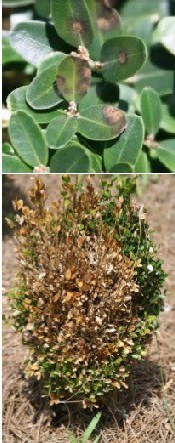Boxwood blight, caused by the fungus Calonectria pseudonaviculatum, is a harsh disease of Dwarf English Boxwood and American or Common Boxwood. This disease has been confirmed within the metro Atlanta and surrounding counties according to Dr. Jean Williams-Woodward, UGA extension plant pathologist.
There are some varieties that are less susceptible to this disease; however, these may act as an asymptomatic carrier and unintentionally introduce the disease into landscapes containing more susceptible cultivars. With weather patterns experienced throughout the year, there is an increase in the potential for spread.
The initial symptoms of this disease include circular tan leaf spots with a dark purple or brown border and black stem lesions or blackening of the stems. Additionally, rapid leaf defoliation is a characteristic symptom that separates boxwood blight from other boxwood diseases. This fungus can spread easily in the landscape and once introduced can be devastating. The best method for management is exclusion.
Do not introduce the disease in your landscape through infected plants or tools. Inspect all new plants to ensure symptoms are not present as well as keep any new plants isolated and separate from existing boxwoods. If you find the disease in your landscape, bag the affected plants and all fallen leaf debris for disposal. Do not compost debris.
If you believe you have this disease on your boxwoods, please bring in a bagged sample to the Fayette County Cooperative Extension Office for identification. There are many diseases on boxwoods and proper identification is essential for proper management. For more information about this and other horticultural questions, phone 770-305-5412.






